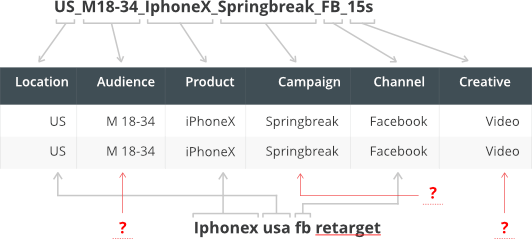What is the first thought that comes to mind when you think of the amount of marketing data you process on a daily basis - big, scattered, messy? More likely than not, it’s all three at the same time.
But don’t worry, you’re not alone.
Most marketers out there are overwhelmed by the sheer amount of data coming their way. After all, there’s dozens of sources and channels to monitor - from social media and online ads, to newsletters, website traffic and search.
If you really want to make sure that you are getting the right insights from your advertising, you need to have a precise layer of rules. One of the most important pillars in this context are consistent naming conventions.
So what are naming conventions exactly?
A naming convention uses standard rules to help users identify various data points or sets more quickly and easily. In marketing, this can mean the difference between being completely lost in a pile of big data, or knowing exactly where to find what. Feeling the pressure already?
The main advantage of naming conventions is that they bring consistency and clarity across all of your marketing data. In a recent blog post, we wrote that in order for your data to yield actionable business insights, it needs to be of high quality - or in other words accurate, up-to-date and complete.
The right naming conventions can speed up your data analysis process even further. If you are working with many campaigns it’s imperative to increase understandability at scale. This goes way beyond the right UTM code for your Google Analytics (even though this is also super important).
What should go in your naming conventions?
Just imagine the following scenario: You’re running advertising campaigns in various parts of the world, targeting different audiences in different time zones with different products on different platforms. Each product has its own budget, different goals. Whew, it’s getting complicated. But it’s worth it to put the extra work in the campaign creation. Let’s see this super simple example:
US_M18-34_IphoneX_Springbreak_FB_15s_Retargeting
UK_F29-49_IphoneX_Summerfun_Vice_300x250_Retargeting
First thing is obvious: keeping consistency makes lifes easier. You are working with different agencies, business analysts and other internal stakeholders, it’s just fair to understand a campaign at first sight. Now, because naming conventions are there to give more structure to your data, your first thought may be to add as much detail as possible.
There is no right or wrong here, but the rule of thumb is to focus on only the most important variables. Write them down somewhere and share it with your team. It makes things just so much easier.
Some facts you might want to consider are:
- demographics
- product line or category
- audience
- region
- date
- media type
It is important not to overcomplicate things. After all, naming conventions are there to make your life easier, not the other way around. And even more so, it can take one small typo to throw off an entire dataset.
How does this affect your analytics?
The real magic comes into play when all your marketing intelligence efforts comes together. Having the right formatting, your analytics or visualisation tool immediately knows how to display your information. Our brains are not made to work with data in tables, we all know that. Instead we get the most out of pretty graphs.
Staying loyal to our example above, you might be looking for all campaigns around the globe for IphoneX? Only retargeting campaigns? Only a specific creative? There is no more obstacle to your cross-country, cross-campaign, cross-format analytics.
The fact of the matter is that with the right naming conventions, you can be sure you can find your data without any hassle. It will be accurate and complete, making your analysis - and the insights you derive from it - more accurate and complete as well. This is much more than just being able to sort a column in your spreadsheets - while this is a start, with the right tools you can get SO MUCH MORE from your data. So, how would this work?
Mapping and transformations make analysts happy
No matter if you are using Adverity or any other data transformation tool, the great thing is that you not only have cleaned and harmonized data, you can easily set up rules to create columns and map your data into the right fields.

This seems trivial but we really want to emphasize how much easier any analysis becomes, once each and every parameter was put into the right column. Please remember, that these processes are automated and you can easily start analyzing your campaign without ever considering cleaning up your data.
And while we argued before that precision is crucial for this, you could go as far and set up rules so the campaign names can be read and mapped to the corresponding fields - even when the syntax is not consistent. Example:
US_M18-34_IphoneX_Springbreak_FB_15s_Retargeting vs. Iphonex usa fb retarget

As you can see, the second example lacks important details like audience, campaign name and creative, but brings in new input ("retarget"). It could make sense to continue your analysis with the existing level of details because nobody asks for the creative anyway.
Depending on the users and goals of your analytics, it could be helpful to further reducing the data complexity and create a mapping table so all those different product names (or creatives etc) are being put into the same consistent format. There are endless options so choose whatever seem useful for your reporting.

While a transformation and harmonization platform might encourage sloppiness, we really want to re-emphasize how important a structure for your marketing intelligence can be. We can't say it often enough.
What to do when data is missing
But what would actually happens when some information is missed? The answer is “it depends”. If you want to map data in order to have a harmonized dataset, you will have to take the necessary steps to ensure that datasets continue to be mapped in a consistent manner. For most of our clients it's like this:
The system (in this case Adverity DataTap) halts its operation and notifies you in the UI about the data error. Yes, this is a serious error, we are not kidding with missing input.

You get a notification on Slack or by email that there is missing information. You better read what this says as most of the times the data integration process is stopped and no more data (at least from the campaign and channel that you were reporting on) is being send to your destination (your data warehouse, Adverity Insights or any other business intelligence or visualisation software).
If you decide to continue working without the missing data, that’s fine, too. There is a simple script that keeps the machine running - it’s just very important that YOU know what data might be missing. Even though 99,9% of this process is automated, there is one thing you need to do here if the process has been stopped: finding the missing information and add it to the database.
So, to summarize: a correct naming convention will make your life much easier as you can reliably measure each aspect of your campaign and quickly show its success to your boss or to your clients. You can not only assess the performance by campaign or country, it is now even possible to compare different performance levels of the same ad format with different messages. Or any other detail from your campaign. Data quality should always be your main concern and in this case, it’s in your hands!












